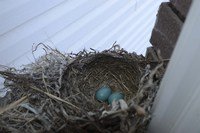Synchronous Hatching Solves Problems
Synchronous vs. Asynchronous Hatching
Post Register May 16, 2013
My four-year-old granddaughter was adamant.
"That mommy robin better come back and sit on that egg so it doesn't die," she said.
It was Mother's Day and she was sure the robin was derelict in her duties. She didn't realize the robin mother still had three or four more eggs to go, and can only produce about an egg a day. Shortly thereafter, the robin deposited a second egg in the nest on our window sill.
What my granddaughter thought was neglect, is actually the way many birds cope with laying only an egg a day, but needing to synchronize the eggs, laid over a week or more, to all hatch at the same time.
Hatching is determined by the length of incubation. Each species has its own “cook time,” but every egg must be incubated for that length of time in order for the embryo to fully develop. So, when a quail lays a clutch of a dozen eggs over as many days, she has a potential problem. If she starts brooding with the first egg, it will hatch 12 days before the last egg. But she needs to have all the chicks hatch at essentially the same time, called synchronous hatching. The hen solves the problem by not initiating brooding until the last egg is laid. That way, all the embryos actually develop for the same length of time despite the fact that their eggs were fertilized and laid up to nearly two weeks apart.
This strategy has some advantages. First, in the case of quail chicks, goslings, ducklings, and other birds that hatch ready to follow mom and find their own food, having all babies hatch at essentially the same time is crucial. In addition, parents don’t have to do double duty by incubating eggs and finding food for hungry chicks at the same time.
But there is another strategy, one performed by a surprising number of birds. When a mother bird begins brooding as soon as the first egg is laid, nestlings hatch in the order the eggs were laid, resulting in young that are in different stages of development in the same nest. The oldest chick (from the first egg laid) may be far larger than the youngest chick from the last egg laid.
This too has its advantages. Where predation pressure is high, or food resources are scarce, staggering feeding demands by the chicks helps to alleviate pressures on the parents. It also minimizes the time it takes for at least one hatchling to make it to fledgling stage. Owls, hawks, herons, egrets, and kingfishers are just a few of the birds that practice asynchronous hatching.
Asynchronous hatching has a dark side, too. Larger siblings often physically and psychologically harass younger siblings. In what is termed siblicide, they may outright kill siblings or starve them to death by outcompeting them in the chow line.
Synchronous or asynchronous hatching are two very different strategies, but produce the same result for birds: successfully raising offspring.
By Terry Thomas

The female robin still has several eggs to lay before she begins to incubate this clutch. All will hatch within a short time of each other.